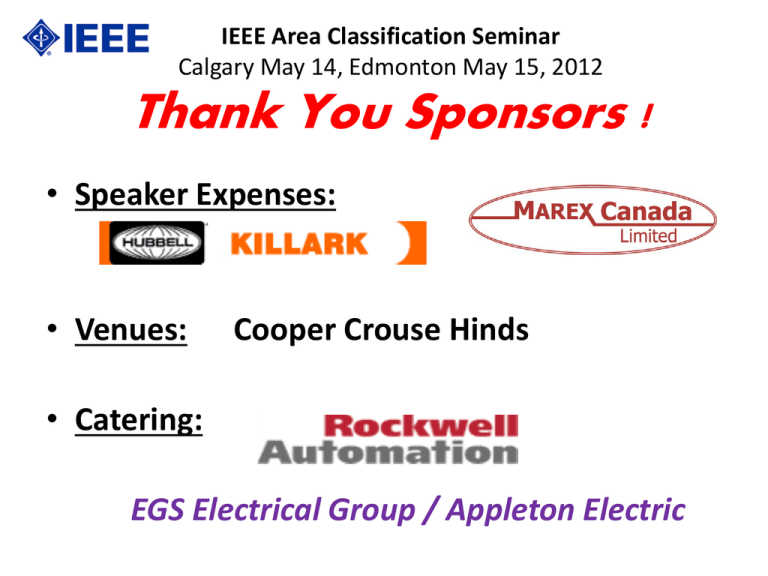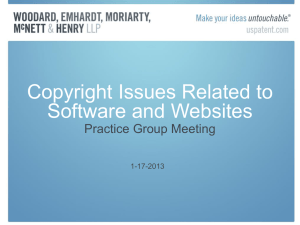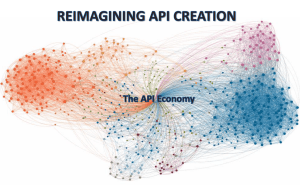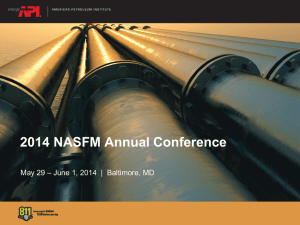CLASS I AREA CLASSIFICATION API RP505 Style
advertisement

IEEE Area Classification Seminar Calgary May 14, Edmonton May 15, 2012 Thank You Sponsors ! • Speaker Expenses: • Venues: Cooper Crouse Hinds • Catering: EGS Electrical Group / Appleton Electric IEEE Area Classification Seminar Calgary May 14, Edmonton May 15, 2012 Future 2012 IEEE Events • Seminar - Power Electronics for Wind Energy Applications – September 17th Calgary, 18th Edmonton – Dennis Woodford, Distinguished Lecturer – Same Time and Location • Tutorial - Electrical Heat Tracing Design – October 16th (tentative), full day – Ben Johnson, Wayne Williams – UofC, MacEwan Hall • Seminar - Power Transformer Specification and Testing – November 19th Calgary, 20th Edmonton – Same Time and Location CLASS I AREA CLASSIFICATION A Practical Approach PRINCIPLES ISSUES WITH RP505(500) WHAT’S NEW? Tim Driscoll / Marty Cole / Vince Rowe HISTORY OF HAZLOC • Early 1900’s - Conversion from Gas to Electric Lighting • 1920 “Extra Hazardous Locations” Later Div 1 • 1931 Classes and Gas Groups • Post WWII Class I, Div 2 • 1982 CEC Cable in Hazardous Locations • Late 1980’s Early 1990’s Identifies Issues With Explosion-Proof Technology – Enclosures and seals HISTORY OF HAZLOC • Awareness of Advantages of IEC HAZLOC Equipment • 1991 API RP500 Concept of Adequate Ventilation • 1991 to Present - Div 1 (Zone 1) to Div 2 (Zone 2) • 1998 CEC Changed Class I to Three Zones and Allowed the Use of IEC Technology for Electrical Equipment DEFINITIONS AND RULES Hazardous location (CEC Section 0) premises, buildings, or parts thereof in which an explosive gas atmosphere is present, or may be present, in the air in quantities that require special precautions for the construction, installation, and use of electrical equipment CLASS I LOCATIONS • Class I locations are those in which flammable gases or vapours are or may be present in the air in quantities sufficient to produce explosive gas atmospheres • This is the “legal” description of a Class I Hazardous Location Division of Class I Locations • Class I locations shall be further divided into three Zones based upon frequency of occurrence and duration of an explosive gas atmosphere as follows: • Zone 0, consisting of Class I locations in which explosive gas atmospheres are present continuously or are present for long periods Division of Class I Locations • (b) Zone 1, consisting of Class I locations in which (i) explosive gas atmospheres are likely to occur in normal operation; or (c) Zone 2, consisting of Class I locations in which (i) explosive gas atmospheres are not likely to occur in normal operation and, if they do occur, they will exist for a short time only; • These are the “legal” requirements for Class I Hazardous Locations. Docs such as RP505 assist in meeting these requirements. All area classification MUST meet these requirements. In some cases documents such as API RP505 may not. • Example: RP505 suggests “adequately ventilated” buildings may be classified Zone 2. Only meets first part of Zone 2 definition Alberta OH&S Code Requirement • Classification of work sites 162.1(1) If the hazard assessment required by Part 2 determines that a work area is a hazardous location, an employer must ensure that • (a) a professional engineer, or a competent person authorized by a professional engineer, divides and classifies the work area in accordance with section 18 of the Canadian Electrical Code, • (b) for any work area falling under the Code for Electrical Installations at Oil and Gas Facilities, the area is divided and classified in accordance with rules 19‐102 to 19‐108 of that Code, Alberta OH&S Code Requirement • (c) for any work area consisting of facilities described in section 20 of the Canadian Electrical Code, the area is divided and classified in accordance with section 20 of the Canadian Electrical Code, and • (d) adequate documentation is prepared and maintained by a competent person, outlining the boundaries of the classified area and any specific measures to be taken to prevent the unintentional ignition of an explosive atmosphere. Alberta Oil and Gas Code • 19-000 Scope (see Appendix B19) • (1) This Code applies to electrical installations used in the search, transmission, or production of oil, natural gas and related hydrocarbons. • (2) This Code does not apply to electrical installations used in: – (a) petroleum refineries; – (b) petrochemical facilities; – (c) gas distribution systems operated by a gas utility at a pressure of 700 kPa or less for the purpose of distributing gas to consumers in all or part of a municipality; and – (d) fuel supply systems for equipment. Alberta Oil and Gas Code 19-100 Hazardous Area Classification (see Appendices B19 and D19) (1) Classification of hazardous locations established and documented by a professional engineer under the engineer’s seal and signature shall be the area classification. (2) Where a facility has not been classified in accordance with Subrule (1), or evidence of an engineer’s involvement is not satisfactory to the inspection authority having jurisdiction, Rules 19-102 to 19-108 shall be the minimum requirement. The Fire Triangle FUEL OXYGEN IGNITION SOURCE The Fire Triangle • Removal of any Side • Removal of Oxygen Side (Gas Blanketing) • Removal of Fuel Side (Process Equipment Design and Operating Procedures, Ventilation) – Ventilation typically used to continuously dilute normal (fugitive emissions) • Removal of Ignition Source Side (Electrical Equipment CEC) (All Equipment OHSC) Probability Approach • Reduce probability of all three sides occurring simultaneously to an acceptable Level • Probability of Explosion = Probability of Explosive Air Fuel Mixture x Probability of Ignition Source • 1975 Paper by Rich Buschart suggests in probability in the range of 1 hour in 106 hours (approx 1 hour in 100 years) acceptable Basis of Equipment in CEC Section 18 API RP505 Table 3 (Fuel and Air Side) Zone Flammable Mixture Present 0 1000 or more hours/year (10%) 1 10< hours/year <1000 (0.1% - 10%) 2 1< hour/year <10 (0.01% - 0.1%) Unclassified Less than 1 hour per year (0.01%) • As probability of flammable mixture decreases probability of ignition source can increase • Probability of explosion approximately the same in all Zones Basis of Equipment in CEC Section 18 • Zone 0 – Only Intrinsically Safe Type ia • Zone 1 – Increased Safety, flameproof, explosion proof, plus “o”, “p”, “q”, “m” • Zone 2- Arcing/sparking devices same as zone 1. Non-arcing devices enclosures suitable to the environment (motors, terminals, etc.) CEC Area Classification Reference Documents • • • • • API RP505 (500) IEC-60079-10-1 Institute of Petroleum IP15 NFPA 497 (Chemical Process Areas) Related Documents – NFPA 496 (Pressurization) – CAN/CSA C22.2 No 60079-2 (Pressurization) – IEC 60079-13 (Pressurization Rooms & Bldgs) – IEC 60079-20-1 (Gas Characteristics, Test Methods) API RP505 • Recommended Practice Not a Code • Guideline not a Recipe • Scope 1.1.1 This publication is only a guide and requires the use of sound engineering judgement (This implies experienced staff not rookies) • Area classification must consider normal AND abnormal operation • Cannot deal with catastrophic situations API RP505 • Section 1 – Scope (non-electrical equipment OHSC) • Section 2 – Government Codes, Rules and Regulations • Section 3 – Definitions (read carefully) • Section 4 – Basic conditions for an explosion (Fire Triangle) API RP505 • RP505 - IEC Group Designations (IIA, IIB, IIC) • Section 18 of CEC (18-050) Equipment with IEC and North American (A, B, C,D) Grouping • Area Classification Documents Should Show Both Groupings • RP505 does not address maximum allowable surface temperature – this is part of the process of area classification Maximum Allowable Surface Temperature • Typically uses Auto-ignition temperatures (AIT) IEC AIT Apparatus Maximum Allowable Surface Temperature • Typically uses Auto-ignition temperatures (AIT) • Hot surface ignition temperatures are higher than AIT (API 2216)(PCIC-97-04)** • Choice of lowest AIT in mixtures frequently an issue • Frequently process piping present at temperatures above chosen AIT. • • • • Maximum Allowable Surface Temperature Alberta OHSC applies following Rule to electrical and non-electrical equipment in hazardous locations 165(3) An employer must ensure that in a hazardous location, (a) equipment used will not ignite a flammable substance Should max temp be lower for electrical equipment than for process equipment? Use of variances where technically supported? API RP505 • • • • Extent of Zone Outer Boundary – Abnormal Operation Common Area of “Over-Classification” Equipment Spacing Should be Considered 6.5.4.5 Misleading around buildings (Fig 53) API Figure 53 API RP505 • • • • • Extent of Zone - Factors Release Rate Relative Vapor Density Volatility Flash Point Topography API RP505 Zone 0 Areas • Relatively Easy to Identify • Typically enclosed areas such as vented storage tanks, or • Around vents from Zone 0 areas • Not inside most process vessels (hazloc def) API RP505 • • • • Zone 1 Areas Inadequately ventilated indoor areas Adequately ventilated indoor areas where explosive atmospheres present for long periods Around process vents Inside vented storage tanks holding combustible liquid or inside flammable gas blanketed tanks API RP505 Zone 2 Areas • Most outdoor areas • Attended or monitored adequately ventilated indoor areas • Around vents • Majority of Class I locations (95%+) API RP505 Adequate Ventilation • Fugitive emission calculations • 6 and 12 air changes suggested in API generally excessive • NFPA 5.5.4 Learn from existing facilities NFPA 497 5.5.4 When classifying buildings, careful evaluation of prior experience with the same or similar installations should be made. It is not enough to identify only a potential source of the combustible material within the building and proceed immediately to defining the extent of either the Class I, Division 1 or Division 2; or Class I, Zone 1 or Zone 2 classified areas. Where experience indicates that a particular design concept is sound, a more hazardous classification for similar installations may not be justified. Furthermore, it is conceivable that an area be reclassified from either Class I, Division 1 to Class I Division 2, or from Class I, Division 2 to unclassified, or from Class I, Zone 1 to Class I, Zone 2, or from Class I, Zone 2 to unclassified, based on experience. API RP505 • • • • • • Adequate Ventilation Fugitive emission calculations 6 and 12 air changes suggested in API generally excessive NFPA 5.5.4 Learn from existing facilities Direct measurement for existing buildings Applies to “normal operation” Does not lead to Zone 2 without means to limit time explosive atmospheres can be present (Zone 2 definition 18-006(c)(i)) API RP505 Unprotected Fired Heaters • Frequent note on area classification drawings where a fired heater is located in area otherwise Zone 2 • Fired heater is classified non-hazardous in accordance with API RP505 Paragraph 6.5.9.2 and 6.5.9.3 • 6.5.9.2 Adequately ventilated locations surrounding equipment that has continuous flame sources (e.g., unprotected fired vessels and flare tips) need not be classified solely by reason of the fuel gas being considered as a source of release. API RP505 Unprotected Fired Heaters Note 2 to Rule 6.5.9.2: The lack of classification around unprotected fired vessels and flare tips does not imply the safe placement of fired vessels and flare tips in the proximity to other sources of release because unprotected fired vessels and flare tips are themselves sources of ignition. The decision of whether or not it is safe to install the unprotected fired vessel or flare tip at the location is outside the scope of this document. API RP505 Unprotected Fired Heaters 6.5.9.3 The practice of not classifying locations where nonelectrical ignition sources (e.g., the open flame of an unprotected fired vessel or flare tip) exist has been utilized in previous issues of RP 500. It is recommended that the application of this practice be limited to unprotected fired vessels or flare tips and that the resulting unclassified locations be restricted to their immediate vicinity. Electrical equipment located in these unclassified locations typically is de-energized for the majority of the time that the flame source is not present. Alberta Occupational Health and Safety Code 168(5) An employer must ensure that a furnace or fired heater is not located or operated in a Division 2 or Zone 2 hazardous location of any Class as defined in the Canadian Electrical Code, unless (a) the combustion process is totally enclosed except for the combustion air intake and the exhaust discharge, (b) all surfaces exposed to the atmosphere (i) operate below the temperature that would ignite a flammable substance present in the hazardous location, or (ii) are shielded or blanketed in such a way as to prevent a flammable substance in the hazardous location from contacting the surface, and (c) the combustion air intake and exhaust discharge are equipped with a flame arresting device or are located outside the hazardous location. API RP505 7.1.3 In most petroleum facilities, there are sources of ignition in addition to those associated with electrical equipment (for example, piping systems and engine manifolds operated at elevated temperatures and unprotected fired vessels). The extent of classified locations is determined only by the location of potential sources of release of flammable liquids, gases, and vapors, and not by the location of sources of ignition -- electrical or non-electrical. NFPA 496 Pressurization Type Z Pressurization • 4.8.1.1* Failure to maintain the positive pressure within a protected enclosure shall be communicated by an alarm or an indicator • 4.8.1.2 It shall not be required to de-energize the protected equipment upon detection of the failure to maintain positive pressure within a protected enclosure. NFPA 496 Pressurization Type Z Pressurization • A.3.3.1 Alarm. An alarm is intended to alert the user that the pressurizing system should be immediately repaired or that the electrical equipment protected by the failed pressurizing system should be removed from service. • Area Zone 2 when pressurization lost • Continued operation without pressurization is “Hot Work” • Proper documentation when used by designers IEC 60079-13 Construction and use of rooms or buildings protected by pressurization • Equivalent to type Z pressurization, action on loss of pressurization – Suitable alarm (visible, audible or both) – Immediate action to restore pressurization – Programmed disconnection of power if pressurization cannot be restored for an extended period of time or if concentration of gas is rising to a dangerous level API RP505 Section 8 - Common Applications • 8.1.2 Specific examples listed consider only the item discussed and do not take into account the possible influence of adjacent areas classified due to other equipment. Application of these examples to similar, though not identical, situations should be made with sound engineering judgment, employing information presented in this RP and other publications. API RP505 Section 8 - Common Applications • Important to read text associated with each figure API RP505 Figure 14 Process Vents API RP505 Section 8 - Common Applications • Important to read text associated with each figure • 8.2.3.1.1 The criteria affecting the extent of the classification of the areas around process equipment vents in non-enclosed areas are too diverse to specify distances. Individual engineering judgment is required for specific cases, but in no case should the classification be less than that shown by Figure 14. API RP505 Typical Figures • API figures may present more than one option. When using API figures for area classification they should be modified to show the actual installation(s) API RP505 Typical Figures • API figures may present more than one option. When using API figures for area classification they should be modified to show the actual installation(s) • Important to read all the information on API figures (flammable, combustible, HVL, etc) API RP505 - Refineries 9.1.3 Refinery processing facilities consist of specialized equipment within which liquids, gases, or vapors are continuously processed at high rates and at elevated temperatures and pressures. Both chemical and physical changes occur in these materials, and during abnormal conditions the composition and properties of stocks may change drastically. These conditions, together with considerations of operating continuity, dictate standards of refinery design that may not be warranted in other petroleum industry operations. API RP505 - Refineries 9.1.3 continued However, although these recommendations are applicable primarily to refinery areas, it is recognized that a modem refinery includes facilities other than those traditionally associated with refining operations. Often petrochemical and chemical facilities are interrelated both physically and by process procedure with refining equipment. The practices recommended in this section can be applied to these additional facilities to the extent that such physical relationships or process similarities exist. API RP505 Production Facilities – Associated Text API RP505 Production Facilities – Associated Text 10.6.3 Hydrocarbon Pressure Vessel • Note 1: Classification is not because of the vessel itself, but for the control valves, sample valves, instrument drain valves, and numerous other valves and fittings around the vessel. Associated equipment (e.g. relief valves, rupture discs, and level controllers) must be considered separately. • Low pressure horizontal vessels often over-classified. Common on heavy oil sites. • Horizontal heat exchangers often classified unnecessarily API RP505 and Oil and Gas Code • Diagrams in Oil and Gas Code (OGC) do not apply to engineered classifications • Use of OGC diagrams often results in improper classification • OGC Wellhead often wrongly used OGC Wellhead –One Size Fits All? API RP505 Beam Pump Wellhead API RP505 and Oil and Gas Code • Diagrams in Oil and Gas Code (OGC) do not apply to engineered classifications • Use of OGC diagrams often results in improper classification • OGC Wellhead often wrongly used • OGC extended area misused, applied unnecessarily API RP505 and Oil and Gas Code • Diagrams in Oil and Gas Code (OGC) do not apply to engineered classifications • Use of OGC diagrams often results in improper classification • OGC Wellhead often wrongly used • OGC extended area misused, applied unnecessarily • Diagram B15 often interpreted to mean Zone 2 does not extend outside buildings. This diagram applies only to water-flood buildings API RP505 and Oil and Gas Code • Diagrams in Oil and Gas Code (OGC) do not apply to engineered classifications • Use of OGC diagrams often results in improper classification • OGC Wellhead often wrongly used • OGC extended area misused, applied unnecessarily • Diagram B15 often interpreted to mean Zone 2 does not extend outside buildings. This diagram applies only to water-flood buildings • Other Zone 2 buildings not possible in OGC! Two Divisions to Three Zones (1998 CEC) • Purpose was not just to change to 3 Zones • Major reason was to access Hazloc Technology • Existing explosion proof approach had issues – Most users did not understand how to properly install and maintain – Required field installed seals to maintain explosionproof rating – Seals were frequently improperly made – IEC designs and change to Zone 2 area classification can eliminate high percentage of seals – Switch to cable eliminates “boundary” seals API 500/505 Updates • Status of 500 – Still in Editorial review (for many months now) • Main reason being the chair being late with review of the page drafts – Hopefully last round complete, and issue shortly – Major changes introduced into 500 are also in 505 • Pressure multiplication factors in Production section • Changes to small valves and fittings in Production section API 505 Updates • API 505 to follow 500 in general, and is now in subcommittee revision work – 3 meetings focussing on 505 have been held (spring and fall 2011, and spring 2012) • Canada representation – Lin Duquette – Tim Driscoll Alliance Pipeline OBIEC Consulting (Shell retired) • Schedule – Estimate publishing by end 2013 API 505 Updates • Elimination of “tie to electrical installations only” – Scope is limited to electrical only – historical – Inconsistent with other world locations (e.g. ATEX in Europe, OH&S in Alberta and Ontario) – Subcommittee will entertain proposal to introduce the concept that “Area Classification can be used to control non-electrical ignition sources” – May not go anywhere as • Lead document, 500, is ready for publishing without this • Big leap for some of the committee members API 505 Updates • Elimination of “Class l” designation – Discussed extensively at NEC and rejected • The feeling is US Zones are different than elsewhere – As a result – very unlikely to happen in 505 • A clause has been added in general section – Zone 2 remote areas need to be monitored to ensure they meet the definition of “..... flammable atmosphere will exist for a short time only” – Have not seen the actual verbiage API 505 Updates • Proposed note at end of SCOPE – Note: Other publications used for the installation of electrical equipment and associated wiring for classified (hazardous) locations based on the IEC or other systems (such as IEC 60079 series documents) are not recommended. Certain protection techniques and wiring methodology are unique to the IEC 60079 series documents and are not applicable when using this area classification document. – A significant issue, as this is a direct conflict with the CEC and statement immediately preceding it in 1.1.2 – Not discussed Spring 2012, but on agenda for Fall 2012 mtg. API 505 Updates • Multiplication factors introduced in Production section, for higher pressure applications – Based on Leak Data, and dispersion modelling (company confidential) • API SOEE requested to gather confidential and release average data. Agreed Fall 2011; no results (or action?) yet – Increases the base boundary distances (vertical and horizontal) as pressures increases • 300ANSI • 600 ANSI • 900 ANSI Low Med. High 0-740 psi 741-1440 psi >1440 psi multiply by 1.0 multiply by 1.5 multiply by 2.5 API 505 Updates • Screwed connections, Flanges, Block Valves, etc. Outside, in Production section now needs to be classified for Med. and High Pressure, >740 psi – Data shows many leaks from these devices (company confidential) – 0.5 m Zone 2 API 505 Updates • Lab Rooms updated • Ignition Temperatures all changed to AutoIgnition Temperature • Changes made to Gas Detectors when used for Area Classification purposes • Hyrocarbon fueled Prime Movers do not need to be Classified up to 125 psi – Should this or similar be a general requirement, and should this pressure be lowered? Appendices • No requirement for determining Max. Temp. during Classification in Appendix E – Committee willing to consider • Appendix F, Alternative Ventilation – Partial description of IEC – Voted to delete Appendix, Fall 2011





